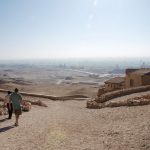The Valley of the Queens
The Valley of the Queens, also known as Biban al-Harim, is a small valley in Luxor, Egypt. It served as a burial site for the wives and children of pharaohs during the New Kingdom period of ancient Egypt. The Valley is situated on the west bank of the Nile, opposite the city of Luxor, and is adjacent to the Valley of the Kings. Despite being smaller and less well-known than the Valley of the Kings, the Valley of the Queens is home to some of the most beautifully decorated and well-preserved tombs in all of Egypt, making it an important destination for visitors interested in ancient Egyptian history and culture.
Historical Significance of the Valley of the Queens
The Valley of the Queens was used as a burial site during the New Kingdom period of ancient Egypt, from the 18th to the 20th dynasty (1550-1070 BCE). It was primarily used to bury the wives and children of pharaohs and members of the nobility. The Valley contains about 70 known tombs, although not all have been excavated.
The tombs in the Valley of the Queens are some of Egypt’s most beautifully decorated and well-preserved. They contain colorful murals and inscriptions that depict scenes from the afterlife and scenes from the lives of the deceased. The tombs also contain various objects and offerings that the deceased would need in the afterlife, such as furniture, food, and clothing.
Some of the most famous tombs in the Valley of the Queens include the tomb of Queen Nefertari, the principal wife of Ramesses II, considered one of the most beautiful in Egypt. Another notable tomb is the tomb of Prince Amunherkhepeshef, the son of Ramesses III, which contains vivid depictions of the prince’s life and the gods of ancient Egypt.
The Valley of the Queens holds great historical significance as a reflection of ancient Egypt’s religious beliefs and customs. The elaborate tombs and their decorations provide insight into the ancient Egyptian view of the afterlife and their ideas about the role of the pharaoh and the gods in the journey to the afterlife.
Top Attractions in the Valley
The Valley of the Queens is a fascinating destination that offers visitors a chance to explore ancient Egypt’s rich history and culture. Some of the top attractions in the Valley include:
Tomb of Queen Nefertari: The tomb of Queen Nefertari is considered one of the most beautiful in Egypt. It features stunning wall paintings depicting scenes from the queen’s life and her journey to the afterlife.
Tomb of Prince Amunherkhepeshef: The tomb of Prince Amunherkhepeshef is another popular attraction in the Valley. It contains vivid depictions of the prince’s life and the gods of ancient Egypt.
Tomb of Queen Titi: The tomb of Queen Titi is notable for its colorful wall paintings that depict scenes of the queen’s journey to the afterlife.
Tomb of Khaemwaset: The tomb of Khaemwaset is an impressive example of ancient Egyptian architecture, featuring a complex of chambers and corridors that lead to a burial chamber.
Tomb of Amenherkhepshef: The tomb of Amenherkhepshef is known for its colorful wall paintings that depict scenes of the prince’s life and the gods of ancient Egypt.
Valley of the Queen’s Temple: The Valley of the Queen’s Temple is a small but well-preserved temple dedicated to the goddess Hathor.
Tomb of Tyti: The tomb of Tyti is notable for its well-preserved decorations and colorful wall paintings that depict scenes of daily life in ancient Egypt.
Overall, the Valley is a fascinating destination that offers visitors a chance to explore ancient Egypt’s rich history and culture through its impressive tombs and temples.
Visiting the Valley of the Queens
Visiting the Valley of the Queens is a must-do activity for anyone interested in the history and culture of ancient Egypt.
Location: The Valley of the Queens is located on the west bank of the Nile River in Luxor, Egypt. It is near the Valley of the Kings and can easily be accessed by car or bus.
Tickets: To enter the Valley, you must purchase a ticket. Tickets can be bought at the entrance of the Valley or in advance online.
Guided Tours: It is highly recommended to take a guided tour of the Valley to learn about the history and significance of the various tombs and temples. Guides can be hired at the entrance of the Valley or through tour companies.
Tomb Access: Not all tombs in the Valley of the Queens are open to visitors, and some may require additional entrance fees. Check which tombs you want to visit and if they are accessible.
Dress Code: It is important to dress appropriately when visiting the Valley of the Queens. Both men and women should cover their shoulders and knees out of respect for the local culture and traditions.
Time of Visit: Visiting the Valley early in the morning or late in the afternoon is recommended to avoid the crowds and the hot midday sun.
Cultural Significance of the Valley
The Valley holds significant cultural and historical importance as it served as the burial place for the queens, princes, and other royal family members during the New Kingdom period of ancient Egypt (1550-1070 BCE).
The tombs in the Valley are adorned with elaborate wall paintings and intricate carvings, showcasing the artistic and architectural skills of the ancient Egyptians. These depictions provide valuable insights into the royal families’ daily life, religious beliefs, and customs during the New Kingdom period.
Additionally, the Valley reflects the important role of women in ancient Egyptian society. The queens and other royal women buried in the Valley were highly respected and revered, and their tombs were constructed with great care and attention to detail.
Today, the Valley continues to serve as a testament to the rich cultural heritage of ancient Egypt and offers visitors a unique opportunity to explore and learn about the country’s fascinating history and culture.
Look here: Ancient Egyptian Foods
Preservation Efforts in the Valley
Preserving the Valley of the Queens is a top priority for the Egyptian government and numerous organizations working to protect and conserve the tombs and artifacts.
Several efforts have been made to safeguard the Valley from the damaging effects of tourism and time. For example:
Limited Access: Not all tombs in the Valley are open to visitors, and those that are accessible have a limited number of visitors per day to prevent overcrowding and minimize damage.
Restoration: Restoration projects have been undertaken to repair and preserve the damaged tombs and artifacts. The work is done using specialized techniques and materials that ensure the original structure and art are preserved.
Education and Awareness: Education and awareness campaigns have been launched to educate visitors on preserving the tombs and artifacts in the Valley of the Queens. Visitors are encouraged to respect the ancient structures and to avoid damaging them in any way.
Technology: Advanced technologies such as 3D scanning and virtual reality have been used to create digital models of the tombs and artifacts in the Valley. This technology can be used to create accurate and detailed replicas, which can be used for educational and preservation purposes.
Who is buried in the Valley?
The Valley of the Queens served as a burial place for queens, princes, and other royal family members during the New Kingdom period of ancient Egypt.
Look here: Cities and Regions of Ancient Egypt
How many tombs are in the Valley?
There are around 80 tombs in the Valley of the Queens, with only a few open to visitors.
What is the significance of the wall paintings in the tombs?
The wall paintings in the tombs of the Valley of the Queens provide a glimpse into the royal families’ daily life, religious beliefs, and customs during the New Kingdom period. They are considered some of the most beautiful and intricate examples of ancient Egyptian art.
Look here: Explore the Rich History and Stunning Beauty of Nasser Lake cruises
Can visitors take photographs inside the tombs?
No, photography is not allowed inside the tombs of the Valley of the Queens to preserve delicate and valuable artwork.
How long does it take to visit the Valley of the Queens?
The time to visit the Valley of the Queens depends on the many tombs you wish to see. A typical visit may take a few hours.
Are there any restrictions on visiting the Valley?
As with many archaeological sites in Egypt, visitors must adhere to certain rules and restrictions, such as no touching or climbing on the tombs or smoking inside the site. Visitors are also not allowed to bring food or drinks into the Valley.
What is the best time to visit the Valley?
The best time to visit the Valley of the Queens is during the cooler months of November through February. However, the site can be visited year-round, with the summer months being particularly hot.
Look here:The Valley of the Nobles
In conclusion
the Valley is a significant historical and cultural site in Egypt. It served as the final resting place for royalty during the New Kingdom period and features beautifully decorated tombs with intricate wall paintings. Preservation efforts are ongoing to protect and conserve the delicate artwork and structures in the valley. Visitors to the site can gain a unique insight into the daily life and customs of ancient Egyptian royalty, making it a must-see destination for anyone interested in history and culture.








